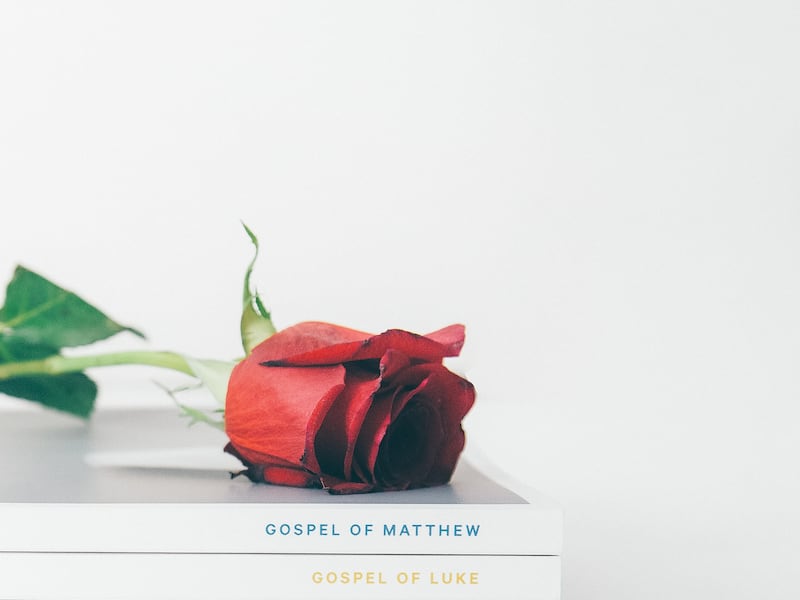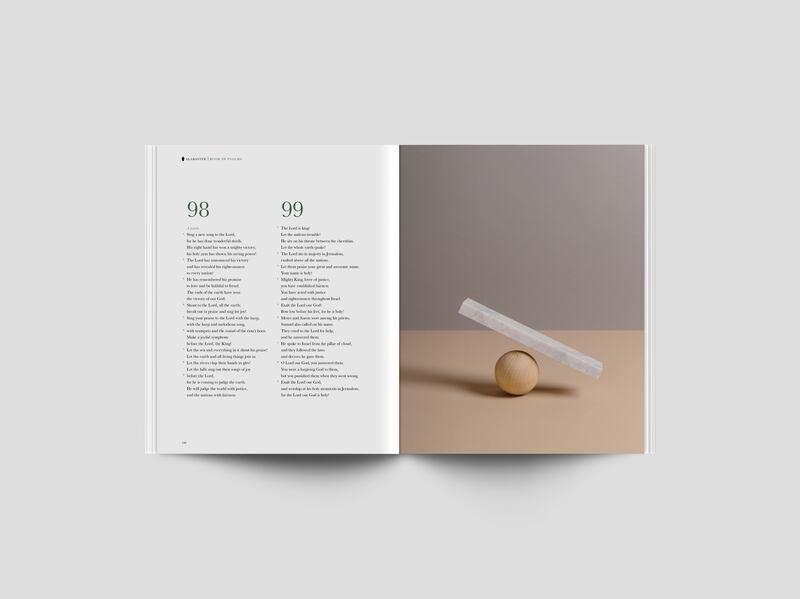SALT LAKE CITY — Open the Book of Romans and you are greeted with two full-page photos. On the left-hand side is a woman in a black dress, eyes closed, hands painted gold, against a purple backdrop. On the right-hand side is a man in a black T-shirt, hands also painted gold, against a red backdrop. Flip the page and you land on several paragraphs of text, printed on top of a photograph of a body of water ringed by mountains at sunset.
It’s exactly the kind of book — artfully designed, expensive-looking, and beautiful — that would show up in the typical millennial Instagram post, placed just so on a pale wood table next to a cup of coffee and a potted succulent.
It’s a Bible for the 21st century, said Bryan Ye-Chung, 25, one of the co-founders of Alabaster Co., a Los Angeles-based company that integrates contemporary photography into individual books of the Bible.
“We’re really interested in seeing how imagery changes the way you interact with the text,” Ye-Chung said. “If you look at millennials and Gen Zers, we’re very visually based people. Everyone has a smartphone with a camera. Everyone is consuming visual media. We wanted to bring that to a faith-based context or brand.”

Alabaster’s Bible books have recently garnered national attention not only for the Instagram-esque photos they contain, but also for being Instagrammable themselves. This raises questions about what happens when faith is repackaged in order to appeal to younger generations more attuned to images than words. Are people buying Alabaster’s Bible books to read them, or to post pictures of them?
“I worry that projects like this can become vanity projects or symbols of status,” said O. Alan Noble, an assistant professor of English at Oklahoma Baptist University and editor-in-chief of the website Christ and Pop Culture.
He added, “It makes you wonder what percentage of the people who are buying it take a picture of themselves reading it and drinking coffee and post it on Instagram. Is there a sense people need to be seen reading and owning this?”
‘The Bible Beautiful’
Brian Chung, 30, Alabaster’s other co-founder, converted to Christianity in 2007, while a student at the University of Southern California. He later began working for InterVarsity Christian Fellowship, an evangelical campus ministry, and met Ye-Chung at a Christian student event in 2012, during Ye-Chung’s freshman year at USC.
The two became friends, bonding over their shared passion for art and faith. (Chung studied business and graphic design, and Ye-Chung studied animation.) By Ye-Chung’s senior year, they had come up with the idea of Alabaster: a redesigned Bible that would use art as a lens to explore and illuminate faith.
Another goal was to make the Bible more accessible and inviting to newcomers. When Chung converted to Christianity, he was given a King James Bible and found himself intimidated by its density, thin pages, and small print.
“He just didn’t know where to start,” Ye-Chung said. “The great thing about art is it makes you think and respond in some way, and that’s our main focus: How we can create imagery that’s going to make you think deeper and respond emotionally and spiritually.”
The great thing about art is it makes you think and respond in some way, and that’s our main focus: How we can create imagery that’s going to make you think deeper and respond emotionally and spiritually. – Bryan Ye-Chung, co-founder of Alabaster Co.
Alabaster, which has the tagline “The Bible Beautiful,” has so far released seven books from the Bible: the four Gospels, Psalms, Proverbs, and Romans. The company has also been growing quickly since its launch in 2016. It sold 5,000 books in 2017 and 10,000 in 2018, and aims to sell 30,000 in 2019, Ye-Chung said. Softcover editions sell for $30 to $38 each and hardcover editions for $70 each.
At the beginning, it took Alabaster about six months to bring a book from concept to reality. Ye-Chung said the team would print out every page from a book of the Bible and paste the pages on the wall, drawing connections between different parts of the text and figuring out which photos or designs would work best. Now, that process takes three to four months.
Looking through the books, sometimes it’s obvious why a certain photo was selected, and other times it’s not immediately clear how the chosen photo relates to the text.
“Our design tries to highlight literary structures in the Bible that people may not necessarily see when they’re reading it,” Ye-Chung said, adding, “We’re trying to create images that aren’t necessarily literal. You’re not going to see ancient images or shepherds in our books. It’s really meant to make you think.”
The images may be designed to make readers think, but they are also designed to be beautiful, and to fit into a certain aesthetic popularized by Instagram: Many photos posted on the platform feature perfectly-arranged, color-coordinated tableaux, so gorgeous that they look almost unreal.

For Noble, of Oklahoma Baptist University, this raises questions about the intention behind incorporating imagery into the Bible.
“What I would wonder about is, what exactly are the images they’re choosing to go along with the text?” Noble said. “Are these images drawing us towards contemplation of passages of Scripture? If they are, that’s a good thing.”
“But,” he added, “if there’s a performative element to this, it’s probably not about the Bible itself: It’s about the object as a status symbol. If I choose a Bible translation and version in order to be seen identifying with a certain group or class or social status — to help craft my identity — I’ve turned the Bible into an object to build myself up, not to grow towards Christ.”
Repackaging the Bible for millennials
The majority of Alabaster’s customers are between the ages of 25 and 34, and the books are explicitly marketed to millennials, according to Ye-Chung.
This is evident in the structure of the books themselves, which can be flipped through similarly to how we scroll through articles on our phones. The text is broken up into easily digestible sections, each of which has a bolded heading. Sometimes an entire page will only contain one paragraph of text, and most chunks of text are paired with a photo. In addition, Alabaster uses the New Living Translation, first published in 1996, which “sets out to render the message of the original texts of Scripture into clear, contemporary English,” according to Tyndale House Publishers.
For Noble, it’s incontestable that the internet, social media, and other forms of pop culture influence the way we interact with and understand complex texts.

“If we’re trained to skim, because we primarily read articles on our phones ... we’re going to have a difficult time sitting down to read a chapter of the Bible,” Noble said. “We’re going to want a very simple translation, or images with Scripture quotes on them that are easily digestible, tweetable, meme-able.”
At the same time, the argument can be made that Alabaster’s books make the Bible more accessible and more appealing to someone who isn’t already a member of a faith group.
Indeed, Alabaster’s success comes at a time when faith groups are brainstorming ways to get people — especially young people — back in the pews. According to data from the 2018 General Social Survey, around 23 percent of Americans affiliate with the label “no religion,” which is about the same percentage of Americans who affiliate with the label “Catholic” or “evangelical.” And 2016 data from the Public Religion Research Institute reveals that 39 percent of adults between the ages of 18 and 29 affiliate with “no religion,” as opposed to 13 percent of adults ages 65 and older.
Ye-Chung said the majority of Alabaster’s customers already consider themselves to be religious, but added, “We do see a lot of our customers putting (the books) on their coffee tables and it becoming a conversation starter for a lot of people.”
However, there’s a difference between picking up a book on a coffee table and flipping through it and actually sitting down to read and contemplate it, said Richard Flory, senior director of research and evaluation at the University of Southern California’s Center for Religion and Civic Culture.
“Any sacred text only makes a difference if you use it,” Flory said, adding that Alabaster’s books “are essentially art objects. People don’t want to use them, they want to look at them.”
Flory also said he wasn’t convinced that Alabaster’s redesigning of the Bible would lead someone who doesn’t already identify as Christian to engage with the text, because the Bible is no longer part of America’s “cultural language.”

When it comes to getting people back in the pews, faith groups have to reckon with the distinction between making faith more accessible and “flattening faith into another consumer product,” Noble said.
He gave the example of a church in Oklahoma, where he lives, that has developed a sermon series based on themes raised in popular movies. The sermons are followed by a movie screening and free popcorn.
“Basically what they’re saying is, ‘You’re comfortable going to a theater, not a church.’ And, ‘You’re comfortable picking up a book of artistic photographs, as opposed to opening up a King James version of the Bible.’ That gets you in the door,” Noble said.
But, he added, “Is that the thing that will keep them in the faith? If we’re starting conversations by having these Bibles on coffee tables, what is appealing to people about these texts? If what’s appealing to them is a hipster aesthetic, that’s not going to last. They’re going to move on.”
Individual vs. community
In the age of Instagram, it’s become particularly difficult to discern between a photo that shares an aspect of one’s life or identity, and a photo intended to advertise a brand and sell a product.
This raises questions about how individuals and organizations can use social media to share posts about faith without simultaneously commodifying it.

Alabaster is by no means the only company straddling this line. In recent weeks, rapper Kanye West has come under scrutiny for his Sunday Services, or star-studded musical worship events that he has held every weekend since January. (He recently held one for Mother’s Day.) During the Coachella music festival on Easter Sunday, West held a massive Sunday Service, in which celebrities and attendees, all dressed in the same color, formed circles on a verdant field and sang gospel music, as well as some of West’s songs.
“The obvious explanation for Sunday Service is that it’s album promotion,” Jia Tolentino wrote in The New Yorker, pointing out that West sold Sunday Service sweatshirts at the event for $225 and socks for $50 “designed to promote God and Kanye at the same time.”
This duality holds true for many Instagram influencers, who use the platform to promote and define their own personal brand — their internet identity — in posts that double as paid advertisements for clothing brands, makeup products and other consumer products.

“What is the brand?” Flory asked, in relation to both Alabaster and West. “Is it the object, or the internal text of the Bible? Is it Kanye, or is it, ‘Let’s get people back to church?’”
If people buy the Alabaster books, Flory continued, “they will just sit on the table and people won’t open them until they take a picture, which is pushing their brand, which is pushing the company’s brand.”
This focus on one’s personal brand has to do with the secular age we’re currently living in and the American Dream’s emphasis on the individual, Noble said.
“We have a very difficult time getting our sense of justification, of orientation, of purpose, of meaning, from a transcendent worth like God, because we live in a materialistic world,” Noble said. “The thing that feels like it gives us the most tangible justification is crafting an identity for ourselves.”
We have a very difficult time getting our sense of justification, of orientation, of purpose, of meaning, from a transcendent worth like God, because we live in a materialistic world. The thing that feels like it gives us the most tangible justification is crafting an identity for ourselves. – O. Alan Noble, an assistant professor of English at Oklahoma Baptist University
But beyond being used to craft a personal identity or signal one’s status or wealth, buying an artistic Bible or a Sunday Service sweatshirt — and sharing pictures of them on Instagram —might also allow individuals to feel like they’re part of a larger community.
“When people take pictures of our products” and post them on Instagram, “it’s them saying, ‘I’m part of this community, and I’m going to show that by taking photos of these books,'” Ye-Chung said.
And even though West’s Sunday Services might serve as a plug for his album and fashion brand, the large-scale concerts also allow “you (to) feel a part of something larger than yourself,” Noble said.
Maybe that’s what all of the Instagram posts of beautiful Bibles and expensive sweatshirts represent: A buried wish to connect with each other, and belong to and believe in something that transcends our individual selves, in a time when connections are both facilitated and fractured by social media.
“The world is so full of people, and they’re all so visible” online that “we all feel like we’re not seen,” Noble said. “If we’re seen, maybe we exist.”








